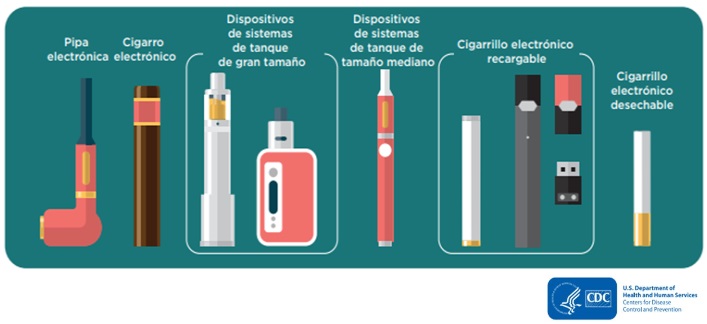Are all vaping products the same?
What is known
They all heat a liquid that is inhaled as an aerosol, and that liquid:
- Does not contain or is tobacco. E-cigarettes are often confused with so-called 'smoke-free' cigarettes. But these devices are not vaping products, as they use heated tobacco, and their risks are very similar to traditional tobacco.
- Contains additives and flavors. At a minimum, it has a mix of propylene glycol and glycerin to make the water vapor look like smoke. It also usually includes other additives to give the product some flavor and smell.
- May contain nicotine and other substances that are restricted to a higher or lesser degree (for example, cannabis-derived substances like THC or CBD), but this is not always the case.
Vaping products have risks, but some more than others. The liquid and the device matter. They can carry different amounts of nicotine, contain additives that might be more or less known, or have dangerous manufacturing defects related to the batteries, which can catch fire, as warned by the U.S. Food and Drug Administration (FDA).
What is not known
Which products are the most harmful. The aerosol produced by e-cigarettes contains toxic substances and heavy metals such as copper or lead. Toxicity is likely to vary depending on the type of liquid and device, as not all additives are the same and, in some products, nicotine is absorbed faster than in others, but it is not clear which products are the most dangerous.
“The degree of addiction will depend on the ingredients of their cartridges and on the heating system”, says by email to SMC Spain Rodrigo Córdoba, family doctor, member of the Tobacco Group of semFYC, and associate professor at the University of Zaragoza. “The different concentration of toxins compared to conventional cigarettes does not mean less risk in the short, medium, and long term”, he clarifies.
The defects they may present. In the United States and Australia, different investigations have found nicotine in e-cigarettes that claim not to have this substance. Furthermore, internationally there are numerous cases of accidental ingestion and other damages due to defects in the device.

Do e-cigarettes cause dependence?
What is known
Those containing nicotine do generate dependence. “We have seen cases of people who smoked them very compulsively and with many self-control issues”, says by email to SMC Spain Francisca López Torrecillas, full professor and director of the Department of Personality, Evaluation, and Psychological Treatment at the Faculty of Psychology of the University of Granada.
Nicotine dependence is very well documented. To a large extent, it depends on the time and amount of nicotine smoked, but it is also important to avoid highs and lows. “If you do something now and get a reward right away, that gratification has a greater effect on behavior than if you receive the reward in three days or three years”, explains in a video call with SMC Spain Josep Mª Suelves, head of the Service for the Prevention and Control of Smoking and Injuries at the Public Health Agency of Catalonia. “The closer a reinforcer is to a behavior, the better it works,” adds the expert, who is also a member of the Board of Directors of the National Committee for Tobacco Prevention.
Electronic cigarettes are designed so that nicotine is absorbed very quickly, as in traditional cigarettes. “Within a few heartbeats, nicotine is acting on a cerebral level,” notes the expert. In contrast, nicotine patches or gums usually seek a more stable effect. “It's like methadone in heroin”, compares Suelves, “that is, looking for something that, instead of working in peaks, a flash, a rush, leaves you enduring”.
Flavors matter. Although electronic cigarettes produce dependence, for now, their regulation is more lenient than that of tobacco. They can be purchased in more establishments and come in a multitude of flavors that make them seem more harmless and attractive. “They taste like lemon and peach, and they induce the idea that they're more like ‘candy’”, says Suelves. “Putting flavors in tobacco is prohibited”, he compares.
With no laws prohibiting it, manufacturers use flavors to attract younger populations. According to a recent report from the WHO, titled Hooking a New Generation: How the Tobacco Industry Captures Young Customers, these flavors are the main reason for trying these products among non-smoking youths. In fact, in a study conducted in the United States, over 70% of teenagers using these products said they would stop consuming them if they only had a tobacco flavor.
Dependence benefits the industry. There are electronic cigarette manufacturers who base their business model on the sale of disposable devices and, therefore, have a commercial interest in keeping that product in use. Ari Atkins, an engineer at the JuuL vaping brand, went so far as to acknowledge in 2015 that their electronic cigarettes are not designed to quit nicotine. “We don't think a lot about addiction here because we are not trying to design a cessation product at all”.
In the report just published by the WHO, the organization denounces the marketing strategies used by tobacco-related companies to clean up their image and attract young audiences. “In some countries, the industry sponsors academic scholarships or the building of schools to encourage positive sentiments and distract from its exploitation of the young”, the report denounces. But their main strategy has been digital marketing on social media platforms like Instagram or TikTok. In fact, in a study conducted in four countries that restrict tobacco advertising, promotional content about electronic cigarettes reached 85% of people aged between 15 and 30.
The WHO report also warns of the pressures faced by those who legislate against the interests of these lobbying groups, which often uses the threat of litigation or actual litigation against anti-tobacco measures, even if these are within the framework of the World Health Organization.
They are being used to generate a new wave of nicotine dependence. The WHO estimates that around 37 million minors aged 13 to 15 use tobacco-related products worldwide. In Spain, the popularity of vaping products continues to grow, especially among young people. According to a Spanish survey from 2023, more than half of students aged 14 to 18 (54.6%) had consumed electronic cigarettes at some point. In Europe, the data follows suit: 32% of 15-year-old adolescents admit to having used these products at some point.
Behind this trend, according to the WHO, would be the marketing strategies of the manufacturers of these products. The industry insists that they are not targeted at children and adolescents, but at the same time, they offer questionable formats and designs. There are electronic cigarettes that look like toys, candy, or feature cartoon characters. Others, however, are discreet and advertise that they can be hidden from family and teachers.
What is not known
If nicotine-free vapes are suitable for quitting smoking. If they do not have nicotine, they should not produce dependence. In fact, according to López Torrecillas, "they could be used to quit smoking cigarettes with nicotine". But they contain other toxic substances, of which many of their risks are still unknown, and in general, it is not clear if they are as effective as other therapies for quitting smoking.
If the habit is escalating. According to Suelves, the problem with vaping products, beyond dependence, is the habit they generate. "At a time when tobacco had lost some glamour, kids aged 12, 13, 18 get access to a product with nicotine or without it, they learn to smoke and multiply by four the likelihood of becoming smokers", warns the expert.
If the user knows what they are consuming. Although the labeling indicates whether a product contains nicotine or not, according to Suelves, the composition can be difficult to understand, leading to confusion. "When I bought this [and shows an e-cigarette in the video call], there was a range of 10, 12, 15 different presentations. Maybe some of them without nicotine, but in the end, I bought the yellow one because it seemed more appealing", he explains.
There could also be issues with labeling, as, as we have seen, nicotine has been found in U.S.-origin products that claim not to contain this substance, which also happened in Australia. In principle, Spain conducts checks to avoid these problems, although Suelves is skeptical. "They can be sold online", he warns.
Are these devices dangerous?
What is known
No tobacco-related product is safe, nor are vaping products, although some risks are better known than others.
Nicotine is a problem. It causes dependency and damage at a pulmonary and cardiac level (COPD, angina or heart attack, among others). In addition, vaping devices can cause burns, serious injuries, or even death if the product is misused or defective (for example, if it explodes or the liquid is ingested).
Ingesting something is different from heating it up and inhaling it. Although vaping devices contain some additives that are safe and common in food, such as propylene glycol, it is unknown what effect they may have if burned and inhaled over decades. In fact, some studies are already beginning to warn of the risk of certain specific additives, such as cinnamaldehyde, ethyl vanillin, or benzaldehyde.
Dual use, combining traditional and electronic cigarettes, is more dangerous than smoking tobacco alone. “According to a recent review of 107 studies, considering five major health problems, the electronic cigarette is 20% less dangerous than the combustible cigarette, but dual use is 20% more harmful than cigarette consumption,” says Córdoba, who is also a delegate of the National Committee for Tobacco Prevention.
What is not known
The outbreak of EVALI. In August 2019, the first cases of lung injuries associated with electronic cigarettes began to appear, a condition known as EVALI for its initials in English (e-cigarette, or vaping, product use-associated lung injury). The symptoms are similar to those of a severe flu or respiratory infection, with cough, shortness of breath, fever, vomiting, or abdominal pain. By February 2020, the Centers for Disease Control and Prevention in the United States (CDC) had confirmed 68 deaths and reported more than 2,800 hospitalizations.
Cases quickly decreased shortly after the alert was raised, but the scientific community began to question the safety of these products in the medium and long term. Some states restricted the use of vaping devices following the incident, although it does not seem that the risk of EVALI is common to all electronic cigarettes. The CDC suggests that the condition could be linked to the presence of vitamin E acetate and THC (active substance of cannabis) in vaping devices of dubious origin. Other substances may have influenced, but this has not been proven.
The effect on pregnancy. In some reports and research, it is suggested that vaping may be an alternative to quitting smoking during pregnancy, but it is a controversial stance. It has not been proven that vaping harms the fetus, although most studies estimate the risk to be high, as research on animal models has confirmed the dangers of nicotine in fetal development. Meanwhile, the WHO discourages its use in adolescents and pregnant women due to the potential effects on brain development.
There are risks that have yet to be established due to time constraints. “The women dying today are my teenage peers. They are people who started smoking three decades ago,” explains Suelves. “Cancer associated with any type of product is something that takes many years to develop,” he adds. Vapes have been on the market for a short time. In the short and medium term, as we have seen, studies indicate they pose a risk to respiratory and cardiovascular health, but long-term monitoring has not yet been adequately conducted.
The risk of developing cancer. Vape smoke contains toxic and carcinogenic substances, but does vaping cause cancer? It's too early to tell. Long-term monitoring has not yet been conducted, and the evidence is limited. “The carcinogenic effect is being investigated,” says Córdoba, although, according to the doctor, there are already indications in experimental models.

Are they suitable for quitting smoking?
What is known
Although they may be effective for quitting tobacco, they are not for quitting nicotine. That is, those who quit smoking may switch to vaping with nicotine for life. “A superficial analysis of the evidence suggests that under professional guidance, it may help in some cases to quit smoking. However, it often leads to a permanent nicotine addiction”, says Córdoba. Additionally, “this is very weak evidence with worrying conflicts of interest”, emphasizes the expert. “Between 1992 and 2016 20% of the authors were funded by the industry”, he notes. “Of 50 papers selected for a systematic review, at least 15 of the authors had conflicts of interest”, he asserts.
In the short and medium term, e-cigarettes present fewer risks than tobacco. Exposure to heavy metals and toxic substances is lower, and some studies show that smoking these substances has fewer risks than tobacco, as long as one product is substituted for another.
Instead of being a substitute, they add. According to a report from the WHO, nearly 70% of American adults who vape also smoke conventional cigarettes. According to Córdoba, these measures do not help to substitute one product for another and promote dual use, meaning that conventional and electronic cigarettes are consumed simultaneously, a consumption pattern that presents more risks than tobacco.
There are safer and more effective options. All therapies have risks, including newer and relatively safe medications like Zyntabac or Todacitan. The former, for example, may cause epileptic seizures, and the latter often generates sleep disorders, irritability, or digestive symptoms, among others. The difference is that they are short treatments, taken for weeks or months, and it is easy to assume and contain the risk, but there is no deadline for vapers.
What is not known
If the strategy of being 'less harmful' works. The main argument in favor of using e-cigarettes to quit smoking is that they pose fewer risks than tobacco. That is, it is better than doing nothing and continuing to smoke tobacco. This stance has strong support in countries where vaping is widespread, such as the United States or the United Kingdom, and is based on a 2014 study which states that e-cigarettes are 95% safer than traditional cigarettes. This contrasts with current evidence, but the industry continues to defend it to this day.
“The tobacco industry has been playing this game since the last century”, says Suelves. “When it started to be said that tobacco is harmful, they show us a carrot that reassures us, and for a while, everyone feels calmer,” he adds. According to the expert, first came the filter. Then, the light cigarettes, which had less nicotine and tar. Then, the ‘combustion-free’ cigarette, which still contains tobacco and combustion, albeit at a lower temperature, and since 2013, it's the e-cigarette. “And all of that is true,” he clarifies. “A filtered cigarette is a bit less harmful. But ultimately, the goal is to convince people to quit smoking. They waste energy on this when we could provide a safer and more effective treatment”, he asserts.
If the benefits are sustained in the long term. These products have not been on the market for long, so it is unknown whether they will continue to be 'less harmful' than tobacco or generate other problems later on.
If smoking nicotine-free vapes is suitable for quitting smoking. Although some specialists consider it an alternative to quit smoking, it's an option that carries long-term risks and, for now, it is not clear whether it is as effective as other therapies for quitting smoking.
How is it regulated in the European Union and in Spain
In the European Union, Directive 2014/40/EU of the European Parliament has limited the size and nicotine concentration of vaping products since 2014. Cartridges should not contain more than 2 ml (10 ml if they are refill bottles) and the nicotine concentration cannot exceed 20 mg/ml. Spanish legislation has maintained these limits to date and no changes are expected with the new anti-smoking plan (the Comprehensive Tobacco Prevention and Control Plan 2024-2027).
Setting these limits "is a somewhat tricky solution", in the eyes of Suelves. According to the expert, these values convey a false sense of security that encourages more smoking. Additionally, the toxicity of nicotine and other substances depends on how the person smokes. "Some light a cigarette, leave it abandoned in the ashtray, and remember it when it has already burned out, and others take many puffs or hold the smoke in their lungs", he compares.
In Spain, Royal Decree 579/2017 regulates the use of electronic cigarettes since 2017. In addition to incorporating the limits of the European Parliament directive, the regulation includes a certain degree of control. Manufacturers must submit annual quality reports and must follow rules for labeling, such as indicating components, not suggesting that one product is less harmful than another, or claiming curative or energizing effects. Advertising is also restricted, and the packaging must include a warning about the risks of nicotine.
But, according to Suelves, the control "is incomplete". "It is not the same as having a limited number of tobacco shops, which are a fixed number and are under the control of a public monopoly that limits the rules of the game", he compares.
In general, current regulation is more lenient than tobacco regulation. Advertising is allowed on the street, the use of vaping products is only prohibited in hospitals and public centers, and they can be bought in any supermarket. Additionally, control is minimal for nicotine-free products: advertising is also allowed, and they can be bought anywhere, including online.
The new anti-smoking plan seeks to tighten this regulation and equate the legislation of these products (whether or not they contain nicotine) with that of tobacco. The plan aims to prohibit sales to minors, restrict advertising, and implement generic packaging like tobacco. It also considers banning their use in other public spaces where smoking is not allowed, although it does not go into detail. This plan "lays the groundwork and the roadmap for the next advances that must be made in legislative matters", stated the Minister of Health, Mónica García, last April when the Interterritorial Council approved the document.
Regulation in other countries
As we have seen, Europe has been relatively quick to regulate electronic cigarettes. The use of vaping products began to become widespread in 2012, and by 2014, it already had the first regulation. But the directive has left room for maneuver. For example, the regulation opens the door to regulate electronic cigarettes as medicines or healthcare products. Countries like Norway, Finland, or Sweden have chosen this path and regulate vaping products as if they were nicotine gum or patches. That is, they cannot be sold anywhere, they must follow manufacturing standards, and before being marketed, a committee of experts has to assess whether the product's efficacy and risk are worthwhile.
Beyond Europe, Australia and Japan regulate nicotine products as medicines, but they do not control nicotine-free products. The United States imposes few restrictions in general, and countries like Kuwait and Saudi Arabia completely prohibit the use of vaping products, whether they contain nicotine or not.
Among the countries that have most recently regulated these devices is the United Kingdom, which this year has banned single-use vaping products and has added a tax on the liquid contained in these devices. The Government has justified the measure as a way to protect minors and to be aligned with the sustainable development goals and the WHO recommendations.
Resources to Learn More
CDC Summary Guide :
WHO Reports on Electronic Cigarettes:
- Technical Note on Call to Action on Electronic Cigarettes
- Nicotine- and Tobacco-Free Schools: Policy Development and Implementation Toolkit
Reports on International Legislation:
- E-Cigarette Ban & Regulation: Global Status as of February 2021 from the Global Centre for Good Governance in Tobacco Control (pdf version)




